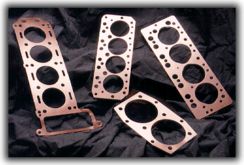NakedTestMonkey
Chemical
- Jun 17, 2005
- 20
I noticed the Subaru's in WRC are using a "headgasketless" (in the normal sense of a single MLS or graphite gasket) design in order to improve cylinder sealing under high boost situations. It involves using a compressible ring in order to provide chamber seal and the remaining seal is bare metal to metal contact (from what I can make out).
It has been suggested that this is a method to reduce shear stress as well as reducing necessary clamping loads via the head studs (reducing cylinder distortion).
My questions are.
1. What is the realism of using this on a street driven vehicle?
2. To what degree would you suggest polishing the surfaces. I know the MLS gaskets require more surface polishing in order to properly seal, but wouldn't the removal of the gasket create a greater need for super-fine polishing of the connected surfaces? Would a less than optimal surface introduce questionable amounts shear due to surface friction?
3. Since the Subaru is using a 2-cyl. per bank configuration would this technology be of lesser benefit in the reduction of head distortion (lift) in a similar large bore / short stroke inline 4-cyl motor due to the transfer of internal forces through-out the head?
4. Clamping loads are reduced because of the increase in surface uniformity? (reduction of riser points?)
My hobby is turning into another degree...
It has been suggested that this is a method to reduce shear stress as well as reducing necessary clamping loads via the head studs (reducing cylinder distortion).
My questions are.
1. What is the realism of using this on a street driven vehicle?
2. To what degree would you suggest polishing the surfaces. I know the MLS gaskets require more surface polishing in order to properly seal, but wouldn't the removal of the gasket create a greater need for super-fine polishing of the connected surfaces? Would a less than optimal surface introduce questionable amounts shear due to surface friction?
3. Since the Subaru is using a 2-cyl. per bank configuration would this technology be of lesser benefit in the reduction of head distortion (lift) in a similar large bore / short stroke inline 4-cyl motor due to the transfer of internal forces through-out the head?
4. Clamping loads are reduced because of the increase in surface uniformity? (reduction of riser points?)
My hobby is turning into another degree...

